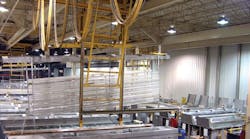Plants that operate on nearly a 24/7 schedule have no room for unexpected downtime. Such is the case with Linetec Inc., Wausau, Wis., a company that provides architectural metal finishing services including painting, powder coating, and anodizing.
On its finishing lines, the facility employs a computer-controlled hoist system to guide material through its anodize process, eliminating any chance of manual variations in precleaning, etching, anodizing, coloring, or sealing. The system ensures a consistent and durable finish on every load that travels through its lines.
However, any system is only as strong as its weakest link, which in this case was the dry brakes used to stop and position the hoists. The brakes required weekly maintenance in addition to monthly overhauls, yet they still experienced periodic failures that brought the anodize process to a standstill. After exploring several different braking options, Linetec maintenance engineers investigated oil shear brake technology from Force Control Industries, Fairfield, Ohio, and decided to try it in their plant.
Brake makeover
To move parts from station to station, Linetec uses eight cranes, each with a 3-hp trolley motor and 15-hp hoist motor. Every motor performs 2,000 moves per shift. Previously, dry Stearns brakes were mounted on each motor to stop and position loads. Because these brakes employ a disc as a sacrificial wear surface, each one had to be checked weekly. In addition, each brake had to be completely rebuilt on a quarterly basis, entailing disassembly, disc and solenoid replacement, checking the gap, and reassembly. This required 7.5 min. for each crane during weekly maintenance, plus 30 min. each per quarter, totaling 124 hours each year on preventive maintenance. In addition to time, the plant was spending another $8,000 per year on maintenance parts, not including unexpected breakdowns.
Further, because all maintenance was performed without removing brakes from motors, scissor lifts were required to reach these crane motors at nearly 30 feet off the ground. Most of the maintenance work was scheduled for the weekend when the plant was idled, but unscheduled failures during the week created problems of a different sort.
“If the brakes failed when the line was running, we’d have to shut down production and go get a scissor lift and the necessary tools and materials,” explains maintenance supervisor Jon Brubacher. “Then we’d do the entire rebuild and get it running again. It was very time consuming and the line was down throughout the entire process.”
With downtime calculated at $1,500 per hour, costs escalated quickly. So when an alternative braking technology was suggested by a system integrator, Brubacher was intrigued. An initial order was placed for a single MagnaShear MSB6 motor brake, which was put into service as a trial. After six months with virtually no maintenance and zero failures, the Linetec team was convinced of the viability of the oil shear design and decided to replace all of their dry brakes.
“We haven’t had a single issue with the new brakes since they were installed,” says Brubacher. “With oil shear brakes on all of our cranes and hoists, we’ve reduced downtime and increased our productivity.”
How oil shear technology works
Traditional dry clutch brakes and other brakes employ a sacrificial surface — the brake disc or pad — to engage the load. With no way to remove the heat caused from engagement between the disc and plate, this material must absorb the heat. Extremely high temperatures eventually degrade the friction material. As the friction surface wears away and begins to glaze, spring force is also reduced, causing the ensuing torque fade. This in turn leads to positioning errors, which require adjustment or replacement of the friction surface.
With oil shear technology, a fluid film flows between the friction surfaces; as the brake is engaged, the fluid is compressed. The automatic transmission fluid (ATF) particles in shear transmit torque to the other side. This torque transmission causes the stationary surface to turn, bringing it to the same relative speed as the moving surface. Because most of the work is done by the fluid particles in shear, by the time the surfaces actually meet or “lock up,” wear is virtually eliminated.
In addition to transmitting torque, ATF helps to dissipate heat and lubricate components. Oil shear technology also provides a cushioned stop that reduces shock to the drive system, further extending service life. Unlike dry clutch brakes, the totally enclosed oil shear system is impervious to external elements from wet, dusty, or dirty environments.
The results of the braking technology makeover have been dramatic. Downtime has been slashed and failures practically eliminated, leading to unprecedented productivity improvements for Linetec.
For more information, contact Force Control Industries at (513) 868-0900 or visit forcecontrol.com.
